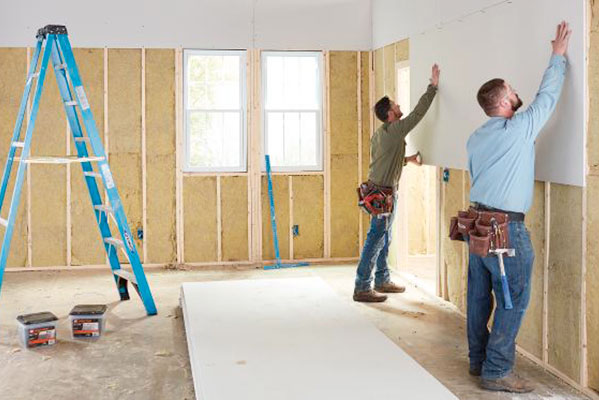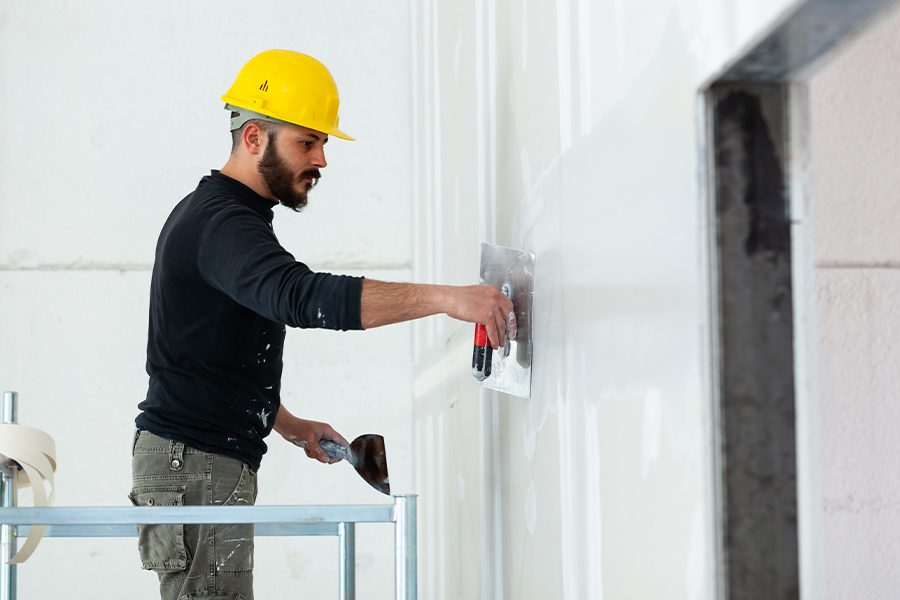Professional Drywall Contractor Services for Your Home Restoration
Professional Drywall Contractor Services for Your Home Restoration
Blog Article
Total Guide to Efficient and Reputable Drywall Setup
Drywall setup is a vital component of any building or remodelling project, requiring a careful approach to make sure both effectiveness and reliability. Recognizing the crucial devices and strategies is vital, in addition to recognizing usual mistakes that can result in substandard results. By carefully preparing the space and implementing ideal techniques, one can achieve a remarkable surface that stands the examination of time. It is important to explore the subtleties of each action in the process, as they jointly add to the general success of the drywall setup. What specific strategies can boost your strategy?
Essential Devices for Drywalling
When starting a drywall installment project, having the right tools is essential for achieving an expert coating. Essential tools consist of a drywall blade, measuring tape, and a T-square, which are basic for accurate measurements and smooth cuts. A drywall lift is likewise extremely advantageous, specifically for ceiling installations, permitting much easier handling of hefty panels.
For fastening the drywall, a cordless drill and drywall screws are needed. The drill needs to be equipped with a drywall bit to guarantee effectiveness and accuracy. Additionally, a key tool is the drywall saw, which helps with cutting around electric outlets and various other obstacles.

In addition, safety equipment such as shatterproof glass and a dirt mask are vital to ensure individual safety and security throughout the setup procedure. Using the right tools not just boosts the high quality of the setup however likewise simplifies the operations, making the task much more efficient total.
Preparing the Area

Next, examine the condition of the ceilings and wall surfaces. Repair any kind of existing damage, such as openings, fractures, or peeling off paint, to ensure a smooth and also surface for drywall application. In addition, check for electric outlets, plumbing lines, and heating and cooling ducts, noting their locations to prevent complications during installment.
It is also critical to determine the room accurately, establishing the dimensions of the ceilings and walls to compute the appropriate amount of drywall required. Create a thorough strategy that includes the design and alignment of the drywall panels.
Installation Methods
Reliable installation methods are essential for achieving an expert coating in drywall tasks. Correct measurement and cutting of drywall sheets are fundamental steps. Always gauge the wall area properly, enabling any type of outlets or switches. Use an utility knife for clean cuts, racking up the paper face and breaking site link the board Find Out More along the scored line.
When hanging drywall, begin with the top and work downward, guaranteeing that the long edge of the board is perpendicular to the framing. Secure the sheets with screws instead of nails, which offer higher holding power and minimize the danger of standing out. Place screws every 12 inches along the edges and every 16 inches in the field of the board.
For edges, make use of edge beads to accomplish sharp, clean edges. When installing on ceilings, use a drywall lift or have a partner aid in holding the sheets in area (drywall repair). Preserve a gap of about 1/4 inch over the flooring and ceiling to fit development and tightening
Completing Touches

Once the tape is in area, it's time to use the initial layer of joint substance, also known as mud. Make use of a 10 to 12-inch taping knife to spread out the compound evenly over the taped joints, feathering the sides to blend with the bordering drywall.
Enable the substance to dry extensively, normally 1 day. After drying, sand the surface area lightly with fine-grit sandpaper to remove any blemishes. drywall installation. Repeat the mudding and fining sand process, normally a couple of layers, making certain each layer is smooth and flush with the drywall surface area
Common Errors to Stay Clear Of
Numerous do it yourself lovers come across pitfalls during drywall installment that can compromise the results. One common blunder is failing to appropriately cut and measure drywall sheets. Imprecise cuts can lead to spaces and irregular joints, making finishing much more labor-intensive. Additionally, disregarding to stagger joints can create weak points in the wall, leading to possible drooping or splitting with time.
One more constant error is incorrect attachment. Making use of as well couple of screws or nails can lead to loose drywall, while overdriving fasteners can trigger the paper to tear, compromising the structure. Go Here It's important to keep consistent spacing, commonly every 16 inches, and to make certain that bolts are flush with the surface.
Moreover, not attending to moisture issues prior to installment can lead to mold growth and architectural damages. Always evaluate the environment and use moisture-resistant drywall in high-humidity areas.
Final Thought
Dependable and effective drywall installment calls for meticulous interest to information throughout the procedure. Avoiding typical errors better adds to a professional result, highlighting the value of accuracy and strategy in successful drywall projects.
It is important to check out the subtleties of each action in the procedure, as they jointly add to the total success of the drywall installment.When embarking on a drywall installation project, having the right tools is important for accomplishing an expert surface.For attaching the drywall, a cordless drill and drywall screws are essential.Properly preparing the space is important for a successful drywall installation.Effective installation strategies are critical for attaining a professional finish in drywall jobs.
Report this page